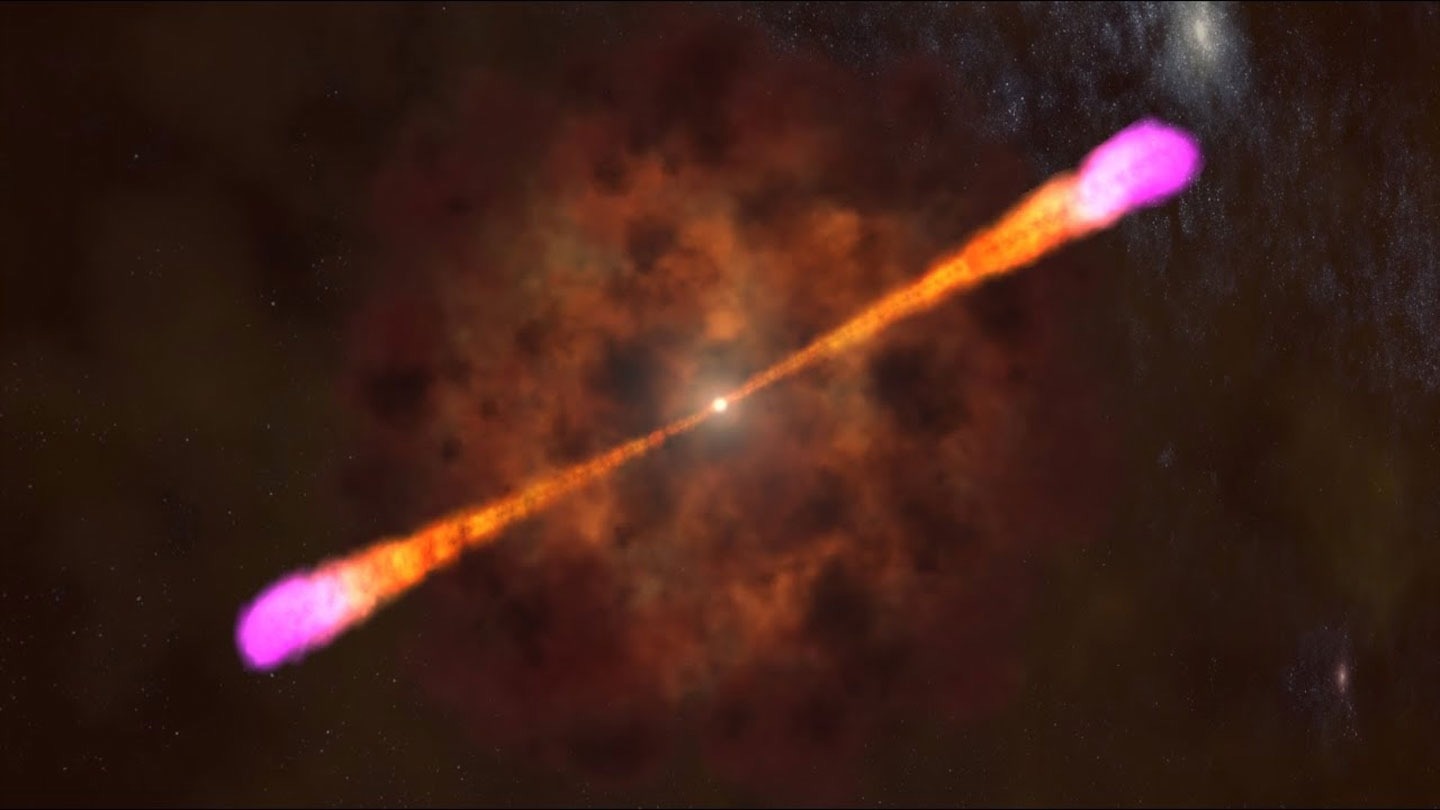Reviewed by Lexie CornerApr 23 2024
Recent research by Dr. Jon Hakkila and team from The University of Alabama in Huntsville aimed to decipher the enigmatic behavior of gamma-ray bursts (GRBs), cosmic phenomena emitting immense energy. By examining the motion of the jets where GRBs originate, their study in The Astrophysical Journal offers insights into the complex mechanisms behind these phenomena, shedding light on their unique properties and challenging theories.
 Artist's concept of a jet of particles piercing a star as it collapses into a black hole during a typical gamma-ray burst (GRB). GRBs are the most energetic and luminous electromagnetic events since the Big Bang. Image Credit: NASA.
Artist's concept of a jet of particles piercing a star as it collapses into a black hole during a typical gamma-ray burst (GRB). GRBs are the most energetic and luminous electromagnetic events since the Big Bang. Image Credit: NASA.
Intense bursts of gamma radiation known as GRBs can produce more energy in seconds than the Sun will make in 10 billion years. Since their unintentional discovery in 1967 by a nuclear surveillance satellite, these transient phenomena have presented one of astrophysics' most difficult riddles.
Lead author Dr. Jon Hakkila of The University of Alabama in Huntsville (UAH), a member of the University of Alabama System, has published a paper in The Astrophysical Journal that focuses on the motion of the jets that give rise to these forces. This paper could potentially provide insight into the behavior of these enigmatic cosmic powerhouses.
Dr. Timothy Giblin, Dr. Robert Preece, and Dr. Geoffrey Pendleton of deciBel Research, Inc. are Co-Authors of the paper.
Despite being studied for over fifty years, the mechanisms by which GRBs produce light are still unknown, a great mystery of modern astrophysics; understanding GRBs helps us understand some of the most rapid and powerful light-producing mechanisms that Nature employs. GRBs are so bright, they can be seen over the breadth of the universe, and–because light travels at a finite velocity–they allow us to see back to the earliest times that stars existed.
Dr. Jon Hakkila, Study Lead Author, The University of Alabama in Huntsville
One mystery is that theoretical models are unable to consistently explain GRB characteristics for their light-curve behaviors.
In astronomy, a light curve is a graph showing a celestial object's light intensity over time. Light curve analysis can help define theories and provide important information about the physical processes that produce them. As a sequence of intense pulses, GRB emission can last anywhere from a few milliseconds to several minutes, and no two light curves are alike.
Pulses are the basic units of GRB emission; they indicate times when a GRB brightens and subsequently fades away. During the time a GRB pulse emits, it undergoes brightness variations that can sometimes occur on very short timescales. The strange thing about these variations is that they are reversible in the same way words like ‘rotator’ or ‘kayak’ (palindromes) are reversible.
Dr. Jon Hakkila, Study Lead Author, The University of Alabama in Huntsville
Hakkila said, “It is very hard to understand how this can happen since time moves in only one direction. The mechanism that produces light in a GRB pulse somehow produces a brightness pattern, then subsequently generates this same pattern in reverse order. That is pretty weird, and it makes GRBs unique.”
Relativistic jets, which are intense streams of radiation and particles ejected from recently formed black holes, are considered the source of GRB emission.
Hakkila noted, “In these models, the core of a dying massive star collapses to form a black hole, and material falling into the black hole is torn apart and redirected outward along two opposing beams or jets.”
Hakkila explained, “The jet material pointing in our direction is ejected outward at nearly the speed of light. Since the GRB is relatively short-lived, it has always been assumed that the jet remains pointing at us throughout the event. But the time-reversed pulse characteristics have been very hard to explain if they originate from within a nonmoving jet.”
The paper suggests giving the jet some motion to shed some light on these properties. “The idea of a laterally-moving jet provides a simple solution by which time-reversed GRB pulse structure can be explained.” The researcher added, “As the jet crosses the line-of-sight, an observer will see light produced first by one side of the jet, then the jet center, and finally the other side of the jet. The jet will brighten and then get fainter as the jet center crosses the line-of-sight, and radially-symmetric structure around the jet's core will be seen in reverse order as the jet gets fainter.”
The structure of GRB jets is partially illuminated by the quick expansion of these jets and the movement of their “nozzle” concerning an observer.
Jets must spray material similar to the way a fire hose sprays water; the jet behaves more like a fluid than a solid object, and an observer who could see the entire jet would see it as being curved rather than straight. The motion of the nozzle causes light from different parts of the jet to reach us at different times, and this can be used to better understand the mechanism by which the jet produces light, as well as a laboratory for studying the effects of special relativity.
Dr. Jon Hakkila, Study Lead Author, The University of Alabama in Huntsville
Journal Reference:
Hakkila., J. et al. (2024) Gamma-Ray Burst Pulses and Lateral Jet Motion. The Astrophysical Journal. 10.3847/1538-4357/ad2f26